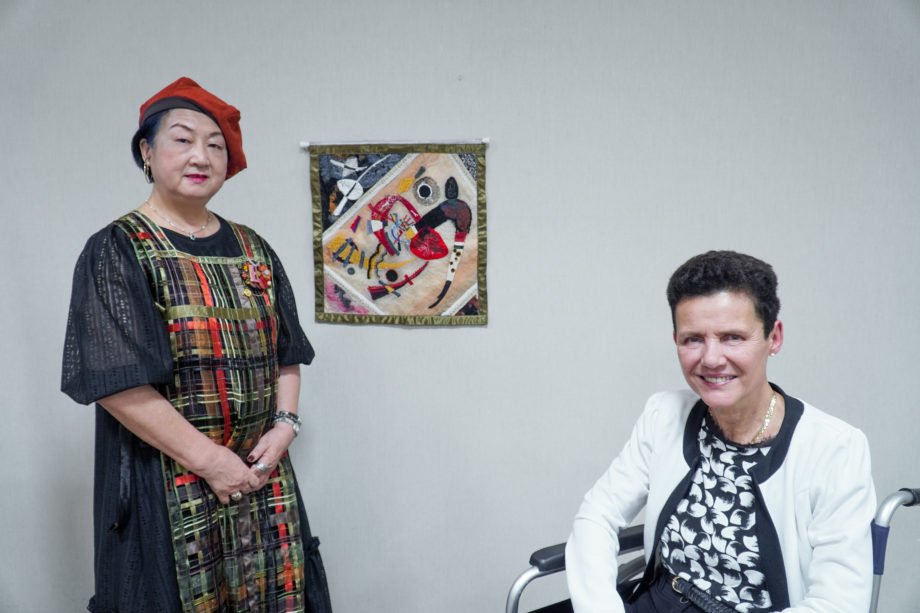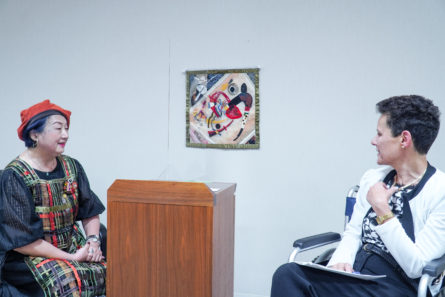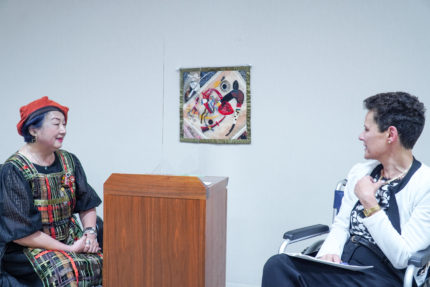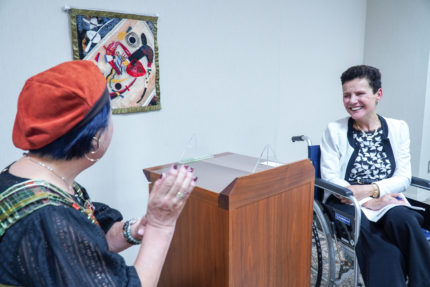- JEPAA Member
- Lace Fabric collage
- Hiromi Okayama
- フリーレースコラージュ
- 岡山裕美
© 2024 Hiromi Okayama.
SCROLL
Portfolio /作品一覧
- カンディンスキー「赤い楕円」のオマージュ/Homage to Kandinsky’s “The Red Oval
- 映画「リトルマーメイド」より/From the movie “The Little Mermaid
- 映画アラジンから「夢は叶う」Dreams come true/Dreams come true” from the movie Aladdin
view more
Interview article /対談記事
師の教えを胸に、自分の表現世界を切り拓く

ゲルマー・トモコ(以下 ゲルマー):岡山先生の手がけているフリーレースのアートは世界的にも非常に珍しく、私も作品を見ながら学ばせていただいています。よろしければこの表現を始めたきっかけからお伺いできますか?
岡山裕美(以下 岡山):元々はパッチワークをやっていたのですが、ある時、テキスタイルアーティストのあらきかずこ先生からフリーレースを学んだことをきっかけに、自分の中でパッチワークとフリーレースを合わせた創作を始める構想が膨らんでいきました。
ゲルマー:今回お持ちいただいた作品も、パッチワークとフリーレースに基づくそうですね。
岡山:はい、この作品はあらき先生が唯一誉めて下さった作品で、映画『アラジン』に着想をもらいました。中央部分は、アラジンのイメージで画面構成してありまして、見る方にアラジンを想像していただければと思います。左右の模様は、ペルシャなどの絨毯を表したものです。
ゲルマー:オリエンタルなイメージが膨らんでいて、素敵ですね。ドイツの展覧会でも人気だったんですけど、作品を鑑賞されている方がみなさん揃って聞いてくるんですよ、「これ、どう(やって製作)しているの?」って(笑)。どんな技術を使ったらこんな美しいものができるんだろうって、不思議でたまらないという顔をなさるんですよ。
岡山:そうですね。たくさんの影響を受けた方です。ただあらき先生はテキスタイルアートの表現者なので、どちらかと言えばドレスなどのデザインを手掛ける人なんですね。私はタペストリーなど面での表現がやりたかったし、パッチワークキルトと合わせたいという構想もあったので、私は私で少し違う方向に進ませてもらっています。
ゲルマー:自分自身の創作を貫いた結果として、『アラジン』などの素晴らしい作品が生まれているのですね。曲線と素材の色の美しさが際立っていますね。
岡山:色とグラデーションでどれだけ想像力を掻き立てられるかが、このフリーレースコラージュの良さであり、難しさでもあると思います。その点はあらき先生からも厳しく指導を受けていますね。
ゲルマー:それにしてもこの作品の曲線の使い方は、まるで抽象画、モダンアートのようですね。素晴らしい技法だなと思います。
岡山:あらき先生の指導を受ける中で、自分なりの表現にもチャレンジしたいと思うようになりました。ちょうどカンディンスキーの作品をフリーレースに解釈する試みをしていた頃ですかね。先生からは、その他に好きな映画から自分の想像力を働かせてフリーレースに起こしてみなさいと助言を受けたりしました。ただ、いざ自分 1 人でやってみようとすると、なかなかうまくいかなくて、その度に頓挫してしまうんです。とくに最後の出来の部分は悪戦苦闘の連続です。だけどこの作品だけは、なぜだかスッとうまくいったんですね。
ゲルマー:カンディンスキーの作品は、ベルリンのシャルロッテンブルク宮殿で開催された展覧会に出品されたものですね。曲線と色で表現する流れや動きがとても素晴らしかったです。
岡山:他にも、2014 年にはゴッホの『ひまわり』をドレスで表現しました。これは下の娘が結婚式のお色直しで着てくれたんですよ。
ゲルマー:それはすごく良い思い出ですね。
岡山:ただ、製作には体力が必要です。想像力を膨らませて、まず一気に形を作り上げる。その後で何日もかけて構成を組み上げていく。やっている間は夢中になっていますけど、終わった後で大きな疲労が残ります。
ゲルマー:こんな美しいものを作るには、やはり相当な苦労があるのですね。最後になりますが、今後の構想、やりたいことなどあればお聞かせ下さい。
岡山:若い人にフリーレースコラージュを通して夢のあるものを作っていってほしいですね。想像力は若い人の方がありますから。素材に使っているリボンは安いものではないけれど、良さを知ってもらえればやってみたいと思ってくれるのではないかと思います。
ゲルマー:あらき先生から岡山先生が学んだように、岡山先生の技術と想像力の大切さを若い人たちに継承していってほしいですね。今日は本当にありがとうございました。
(2022年特別対談 岡山裕美×ゲルマー・トモコ)
Opening up her own world of expression through the teachings of Master

映画アラジンから「夢は叶う」Dreams come true
Tomoko Germar: Ms. Okayama, your free lace art is something rarely seen in the world, and I really feel like I learn something when I view your work. If you don’t mind, could you tell us how you started in this artistic style?
Hiromi Okayama: Well, originally I was doing patchwork, but one day I learned free lace from a textile artist, Kazuko Araki, and so this idea of starting on creative works combining patchwork and free lace grew in my mind.
Germar: And the piece you’ve brought along this time is also based on patchwork and free lace, right?
Okayama: Yes, this piece was inspired by the movie“Aladdin.”It’s the only piece of mine that Ms. Araki ever praised. The central part of the work is based on the image of Aladdin. I hope whoever sees it can imagine Aladdin. The patterns on the left and right sides represent carpets from Persia and other countries.
Germar: The oriental imagery is very stylish. Your piece was popular at the exhibition in Germany, and people viewing it kept asking me,“How was this made?”(She laughs) They look at it with wonder, wondering what kind of techniques were used to create such beauty.
Okayama: Well, I’m only using the technique independently developed by Ms. Araki, but I am very grateful they feel that way. Free lace is not a material that can be sewn, so I suppose it can seem rather mysterious. Certainly, these tapestries are made by pasting together rather than sewing. Ms. Araki originally used gum tape and other materials, but after talking it over with specialists, she arrived at her current technique.
Germar: When I was researching free lace, I read many articles about Ms. Araki. She’s truly amazing, and a leading expert in this field.
Okayama: Yes, that’s right. She has influenced me a lot. However, since Ms. Araki expresses herself through textile art, she is more involved in design of dresses and the like. I wanted to do artistic expression in tapestries and other styles, and I also had the idea of combining it with patchwork quilting, so I am taking it in a slightly different direction.
Germar: So as a result of following your own creative process, you have created wonderful works such as“Aladdin.”The beauty of the curving lines and the colors of the materials are outstanding.
Okayama: I think both the beauty and the difficulty of free lace collage lie in the extent to which the colors and gradations are able to capture the imagination. I received strict instruction from Ms. Araki on this aspect.
Germar: Still, the use of curving lines in this piece is like an abstract painting, like modern art. The technique is wonderful.
Okayama: Under Ms. Araki ’s guidance, I became interested in the challenge of expressing myself in my own way. I guess it was right around the time when I was trying to interpret Kandinsky’s works into free lace. Ms. Araki also advised me to use my own imagination to create free lace works inspired by my favorite movies. But when I tried to do it on my own, it didn’t go very well and I failed every time. The final section, in particular, was a constant struggle. But with this one, for some reason, everything went smoothly.
Germar: Kandinsky’s work was shown in an exhibition at the Charlottenburg Palace in Berlin. The flow and motion expressed by curving lines and colors were exquisite.
Okayama: Aside from that, in 2014, I tried to represent Van Gogh’s“Sunflowers”as a dress. My younger daughter wore that dress at her wedding reception.
Germar: What a wonderful memory.
Okayama: However, the production process requires a lot of energy. You have to let your imagination take flight, and create the form at a single swoop. After that, it takes days to build up the composition. I’m completely absorbed while working on it, but when I’m done, I’m really exhausted.
Germar: It must take a lot of hard work to create something so beautiful. Finally, can you tell us about your future plans and what you would like to achieve?
Okayama: I’d love to see young people making dreamlike creations with free lace collage. Young people tend to have more imagination. The ribbons I use for my materials are not cheap, but I think that, if young people knew how great it is, they’d give it a try.
Germar: I hope that young people will benefit from the importance of your technique and imagination, just as you learned from Ms. Araki. Thank you very much for your time today.
(Special Talk Session in 2022, Hiromi Okayama and Tomoko Germer)
フリーレースとの出会いで花開いた創造の才

カトリン=スザンネ・シュミット(以下 シュミット):お越しいただき誠にありがとうございます。カトリン=スザンネ・シュミットです。よろしくお願いいたします。
岡山裕美(以下 岡山):実は本日生まれて初めてドイツ語を覚えてきました。Ich heiße Hiromi Okayama.(私の名前は岡山裕美です。)
シュミット: おぉ! Das ist sehr gut.(とてもいいですね。)素晴らしいです。本日はよろしくお願い致します。 こちらの作品はカンディンスキーの作品に似ていますね。これは彼の作品をモチーフにした作品ですか。
岡山:はい、今からちょうど 100 年前にカンディンスキーが制作した作品「赤い斑Ⅱ」をモチーフに作りました。ちょうど 100 年経ったということを記念に作ったものです。特にカンディンスキーの色が素敵だなと思いまして。
シュミット:岡山先生が制作をするときは他の作品をモチーフに作られるのでしょうか。
岡山:必ずそうというわけではないです。ただカンディンスキーが大好きだったので作ってみようと思いました。私は絵が描けないので、抽象画であれば誰でも自分の想像の中で理解できるじゃないですか。
シュミット:この一つ一つの形を見てみても面白いですよね。どうしてこのような色彩で、この形にしたのだろうとつい考えてしまいます。
岡山:私もそうです。自分なりの理解の仕方で、フリーレースで制作したら面白いかもしれないなと思って制作をしました。カンディンスキーの作品は赤とか白とか黄色とか青とかがすごく強調されているじゃないですか。また、彼が音楽をやっていたということで見えないものを形にしようとしたところも非常に面白いと思っています。
シュミット:フリーレースとはどのような形で出会ったのですか?
岡山:私はテキスタイルアーティストのあらきかずこ先生から教えていただきました。先生は編み物もやってらっしゃるのですが、その端材を利用して考案されたそうです。
シュミット:それはいつ頃になりますか? 子どもの頃からでしょうか。
岡山:小さい頃から物作りをするのは好きだったのですが、フリーレースを始めたのは 18 年前からです。最初にあらき先生の授業を受けてみた時には「自分にはできないな」と思ってすぐに「やめます」とあらき先生に伝えたところびっくりされて、最初からそう言わずにやってみなさいと言われてそれから今日まで続いています。
シュミット:最初に拒絶していたものが、今日まで続く芸術になったのですね。とても面白い、人生の出会いは不思議ですね。ところで今まで何枚くらい作品は製作されましたか?
シュミット:どちらも生活のために必要なものだと思いますね。ドイツでは、音楽と芸術は生活の一部です。さらに人間の基本的な欲求の一つに音楽と芸術を求めるというものがあるのではないかと思います。それに私は音楽が大好きです。子どもの頃から合唱団にも参加してやっておりました。また交響楽団の理事をしていたこともあります。
岡山:私もコロナで生活が変わって癒しが大切だなと改めて感じました。例えば日本でも駅にピアノを置いて演奏するみたいなことも増えましたけど、やはり人は芸術や音楽を求めているんだなと思いました。
シュミット:それはドイツにも似たような光景がありましたね。音楽は困難な状況でも私たちの救いになってくれるものですよね。ちなみに岡山先生はコロナが感染拡大してから作品制作に対しての心持ちに変化はありましたか。
岡山:終息に向かう今だからこそ、もしコロナがなかったら出会えなかった人もいるのではないかなと思っています。これまでは百貨店とかギャラリーとかに出展をしていたのですが、自分の思いを形にしたものを届けるということに専念できるようになりましたね。だからこそこの思いを人に届けたいと思いが強くなりました。
シュミット:頑張ってください。最後に、今後の創作活動で先生自身がやっていきたいこと、チャレンジしたいことはありますか。
岡山:これからも自分がやっていることをいろいろな人に作品を見てもらえたらと思います。自分が好きなことをやっていたら、明るく生きていられるかなって思っています。その明るさがみんなに伝わればいいかなと思っています。だからこれからも人生を心から楽しみたいと思っています。
シュミット:本当にいいことをお伺いできました。素晴らしいです。本日はありがとうございました。
(2022年特別対談 岡山裕美×カトリン=スザンネ・シュミット)
Creative Talent Budding from an Encounter with Free Lace
Katrin-Susanne Schmidt: Thank you for coming today. I’m Katrin-Susanne Schmidt. I’m very pleased to meet you.
Hiromi Okayama: It’s funny, but I learned German for the first time today. Ich heisse Hiromi Okayama (my name is Hiromi Okayama).
Schmidt: Ah! Das ist sehr gut! (That ’s wonderful!) I’m very pleased to meet you.This piece reminds me of Kandinsky’s work. Did you use one of his pieces as a motif?
Okayama: Yes, the motif is from Kandinsky’s “Landscape with Red Spots, No. 2,”which he painted 100 years ago this year. I painted it to memorialize the 100th anniversary of the piece.
Schmidt: Do you always use motifs from other works when you paint?
Okayama: Not always. I just really like Kandinsky, so I thought I’d give it a shot. I can’t draw well, so I figured my art would be best appreciated if I did abstracts. I especially like Kandinsky’s use of color.
Schmidt: Just looking at each of the shapes is fun. You find yourself asking,“why did he use this color here or make this shape?”
Okayama: I’m the same way. I thought it would be fun to make something out of free lace in the way I interpreted the piece. In Kandinsky’s pieces, colors like red, white, yellow, and blue really stand out, right? I also find it really interesting that, since he also made music, he tried to give form to things we can’t see.
Schmidt: How did you get involved with free lace?
Okayama: I learned about it from textile artist and teacher Kazuko Araki. She does knitting, and she says she came up with the idea of free lace with the scrap left over from knitting.
Schmidt: So when did you start? When you were a child?
Okayama: I liked making things since when I was little, and I started working with free lace 18 years ago. When I first took her class, I thought I’d never be able to do it and told her right away that I was quitting. She was really surprised, and told me that I should just give it a proper try anyway. The rest is history.
Schmidt: So something you rejected at first became an art style that you practice even now. That’s fascinating! It’s funny the encounters we have in life. How many pieces have you made so far, then?
Okayama: I’ve made about 20 tapestries like this piece. But if I included clothing, masks, and other small things like that, there would be too many to count. I have two daughters, and I made both of their wedding dresses.
Schmidt: From everyday things to extraordinary things like wedding dresses, you can make it all! That’s amazing.
Okayama: Yes. The possibilities of free lace honestly surprise me sometimes when I making something. Could I ask you a question now? I have this image of Germany as a country that loves music. So as a German, how do you view the relationship between music and art?
Schmidt: I think both are essential in our lives. In Germany, music and art are part of life. At a fundamental level, I think people crave music and art. I am absolutely a music lover. I sang in a choir as a kid, and later directed a symphony.
Okayama: My life changed when COVID-19 came, and it reminded me of how important it is to have something that brings comfort. In Japan, for example, you see more and more people putting down pianos in train stations and playing. It just shows how much people are looking for music and art.
Schmidt: The same kind of thing is happening in Germany. Music saves us when the going gets tough.By the way, did your attitude toward making art change at all when COVID-19 hit?
Okayama: With the worst behind us now, I think on the people I wouldn’t have met if COVID-19 had never happened. I had previously had my art on display in places like department stores and galleries, and when COVID-19 came, I found that I could now devote myself to creating expressions of the ideas in my head. And it increased my desire to share these ideas with others.
Schmidt: Keep up the good work! Lastly, is there anything that you still want to do or try with your art?
Okayama: I hope all kinds of different people will continue to appreciate what I make. If I can keep doing what I enjoy, I’ll live a happy life. And I hope that happiness comes across to others. That’s why I plan to live life to the fullest!
Schmidt: That’s such a beautiful sentiment. I love it. Just fantastic. Thank you very much for your time today.
(Special Talk Session in 2022, Hiromi Okayama and Katrin-Susanne Schmidt )
Solo exhibition/個展
特設個展ブースin 日欧宮殿芸術祭2022
会期:2022年4月24日~26日
会場:ハル ドゥ ブラン マントゥ(フランス・パリ)
主催:一般社団法人 日欧宮殿芸術協会
運営:クリエイト・アイエムエス株式会社
Solo Exhibition at the JEPAA Festival 2022
Date: April 24th – 26th, 2022
Venue: Halle du Blanc Manteau, Paris, France
Organizer: Nippon-Euro Palace Art Association
Operated by: Create IMS Co., Ltd.
Profile /経歴
岡山裕美 Hiromi Okayama
1952年生 佐賀県出身
師・あらきかずこ
日本手芸普及協会会員、日欧宮殿芸術協会会員
作品出展国遍歴(JEPAA関連事業):ドイツ、フランス、カナダ他
Born: 1952 Saga, Japan
Master: Kazuko Araki
Affiliate Group: Japan Handicraft Instructors’ Association,JEPAA
Exhibition of Works(JEPAA): Germany, France, Canada…











